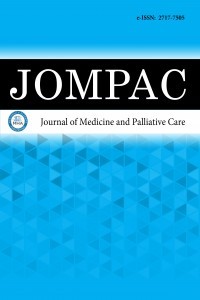COVID-19 ve palyatif bakım
Her gün pozitif vaka ve ölüm oranlarının arttığı COVID-19 pandemisinde, tıbbi tedaviye duyulan ihtiyacın, sağlık sisteminin ve özellikle de yoğun bakım ünitesi yataklarının ve ventilatörlerin kapasitesini aşması beklenmektedir. Sağlık hizmeti sağlayıcıları, hayatta kalma şansı daha yüksek olan hastalar için yoğun bakım ünitesi bakımına ve ventilatör desteğine öncelik verme konusunda zor etik kararlarla karşı karşıyadır. Palyatif bakımın COVID-19 pandemi planlamasına entegrasyonu, sağlık hizmeti sağlayıcılarını öngörülemeyen durumlara hazırlanmak ve gereken kaynaklarla donatmak için çok önemlidir. Pandemi sırasında palyatif bakımın rolünü inceleyen araştırmalar, hastane ortamında yeni palyatif bakım modelleri geliştirmek için stratejilere odaklanmıştır. Sınırlı kaynaklar ile bakım, yararlı olmayan tedavinin durdurulması, semptom kontrolü ve palyatif müdahaleler, palyatif bakım sunum yöntemleri, ölüm ve yas desteği gibi konularda ihtiyaçlar doğrultusunda kılavuzlara ihtiyaç duyulmaktadır.
Anahtar Kelimeler:
COVID-19, palyatif bakım, yoğun bakım
COVID-19 and palliative care
In the COVID-19 pandemic, where positive case and death rates are increasing every day, the need for medical treatment is expected to exceed the capacity of the health system, especially the intensive care unit beds and ventilators. Healthcare providers are faced with difficult ethical decisions to prioritize intensive care unit care and ventilator support for patients with a higher chance of survival. The integration of palliative care into COVID-19 pandemic planning is crucial to preparing and equipping healthcare providers for unforeseen situations. Research examining the role of palliative care during the pandemic has focused on strategies for developing new palliative care models in the hospital setting. Guidelines are needed in line with the needs in subjects such as care with limited resources, withholding non-beneficial treatment, symptom control and palliative interventions, palliative care delivery methods, death and bereavement support.
Keywords:
COVID-19, palliative care, critical care,
___
- Jiang F, Deng L, Zhang L, Cai Y, Cheung CW, Xia Z. Review of the clinical characteristics of coronavirus disease 2019 (COVID-19). J Gen Intern Med 2020; 35: 1545-9.
- Zhu J, Ji P, Pang J, et al. Clinical characteristics of 3062 COVID-19 patients: A meta-analysis. J Med Virol 2020; 92: 1902-194.
- World Health Organization. WHO Coronavirus Disease (COVID-19) Dashboard, https://covid19.who.int/, Erişim Tarihi:14.02.2021.
- World Health Organization (WHO), Integrating palliative care and symptom relief into primary health care: a WHO guide for planners, implementers and managers. Geneva: 2018, https://apps.who.int/iris/handle/10665/274559, Erişim Tarihi: 30.01.2021
- Mizumoto K, Kagaya K, Zarebski A, Chowell G. Estimating the asymptomatic proportion of coronavirus disease 2019 (COVID-19) cases on board the diamond Princess cruise SHIP, Yokohama, Japan, 2020. Euro Surveill 2020; 25. doi:10.2807/1560-7917.ES.2020.25.10.2000180
- Wu C, Chen X, Cai Y, et al. Risk factors associated with acute respiratory distress syndrome and death in patients with coronavirus disease 2019 pneumonia in Wuhan, China. JAMA Intern Med 2020; 180: 934-43.
- Fadul N, Elsayem AF, Bruera E. Integration of palliative care into COVID-19 pandemic planning. BMJ Supportive & Palliative Care. doi:10.1136/bmjspcare-2020-002364
- Borasio GD, Gamondi C, Obrist M, Jox R. COVID-19: decision making and palliative care. Swiss Med Wkly 2020; 150: w20233. doi:10.4414/smw.2020.20233
- WHO definition of palliative care, http://www.who.int/cancer/palliative/definition/en/, Erişim tarihi: 12.01.2021
- Özçelik S. Palyatif bakıma bakış ve hemşireliğin rolü. J Med Palliat Care 2020; 1: 76-82.
- Sheehan J, Ho KS, Poon J, Sarosky K, Fung JY. Palliative care in critically ill COVID-19 patients: the early New York City experience. BMJ Supportive & Palliative Care 2020. doi:10.1136/bmjspcare-2020-002677
- Maves RC, Downar J, Dichter JR, et al. Triage of scarce critical care resources in COVID-19 an implementation guide for regional allocation: an expert panel report of the task force for mass critical care and the American College of chest physicians. Chest 2020. doi:10.1016/j.chest.2020.03.063.
- Yang X, Yu Y, Xu J, et al. Clinical course and outcomes of critically ill patients with SARS-CoV-2 pneumonia in Wuhan, China: a single-centered, retrospective, observational study. Lancet Respir Med 2020; 8: 475–81.
- Bhatraju PK, Ghassemieh BJ, Nichols M, et al. COVID-19 in critically ill patients in the Seattle Region - Case series. N Engl J Med 2020; 382: 2012–22.
- Hendin A, La Rivière CG, Williscroft DM, O’Connor E, Hugles J, Fischer LM. End-of-life care in the emergency department for the patient imminently dying of a highly transmissible acute respiratory infection (such as COVID-19). CJEM 2020:1–4.
- Arpacıoğlu S, Baltalı Z, Ünübol, B. COVID-19 pandemisinde sağlık çalışanlarında tükenmişlik, Covid korkusu, depresyon, mesleki doyum düzeyleri ve ilişkili faktörler. Cukurova Medical Journal 2021; 46: 88-100.
- Calton B, Abedini N, Fratkin M . Telemedicine in the time of coronavirus. J Pain Symptom Manage 2020; 60: 12-4.
- Çelik F, Gündüz N. COVID-19 pandemisinde Yas. Klinik Psikiyatri Dergisi 2020; 23: 99-102.
- Savaş E. COVID-19 sürecinde yas. Türkiye Sosyal Hizmet Araştırmaları Dergisi 2020; 4: 82-9.
- Başlangıç: 2020
- Yayıncı: MediHealth Academy Yayıncılık
Sayıdaki Diğer Makaleler
Gülşah GELİŞİGÜZEL, Salih CESUR, Kader ARSLAN, Şerife Altun DEMİRCAN, Ülkü SİYAH, Sami KINIKLI
Suat BENEK, Mehmet ZENGIN, Sema ZERGEROĞLU, Ahmet BAYDAR, Murat SEVMİŞ
